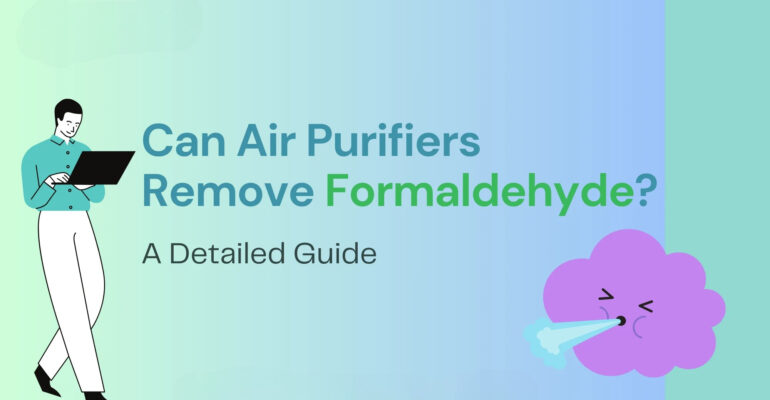How Well Do Air Purifiers Remove Formaldehyde?
August 3, 2024 2024-08-03 10:06How Well Do Air Purifiers Remove Formaldehyde?

How Well Do Air Purifiers Remove Formaldehyde?
Formaldehyde is a common indoor pollutant that can have significant health impacts. Found in building materials, household products, and as a byproduct of combustion processes, it poses risks ranging from irritation of the eyes and respiratory system to cancer with prolonged exposure. Given its prevalence and potential dangers, many people look to air purifiers as a solution. But how well do air purifiers remove formaldehyde? Let’s explore the effectiveness of different air purification technologies in tackling this harmful compound.
Understanding Formaldehyde
Formaldehyde (CH2O) is a volatile organic compound (VOC) that is released from various sources, including:
- Building Materials: Products like plywood, particleboard, and MDF often contain formaldehyde-based resins.
- Household Products: Paints, varnishes, adhesives, and cleaning agents may emit formaldehyde.
- Combustion Sources: Cigarette smoke, gas stoves, and other combustion processes can release formaldehyde into the air.
Given its widespread presence, it’s essential to address formaldehyde pollution effectively, especially indoors where concentrations can be higher.
Air Purifiers and Formaldehyde Removal
Air purifiers use various technologies to clean the air, each with different levels of effectiveness against formaldehyde:
- Activated Carbon Filters
Activated carbon filters are among the most effective methods for removing formaldehyde. These filters contain porous carbon materials that trap gas molecules through adsorption. When air passes through the activated carbon, formaldehyde molecules adhere to the surface of the carbon granules, effectively removing them from the air.
- Mechanism: Activated carbon works through a process called adsorption, where formaldehyde molecules stick to the surface of the carbon. This process is influenced by factors such as the surface area of the carbon, the pore size distribution, and the airflow rate through the filter.
- Effectiveness: The efficiency of activated carbon filters in removing formaldehyde depends on the amount of carbon, the design of the filter, and the specific conditions of use. High-quality filters with a large amount of activated carbon are more effective at capturing formaldehyde and other VOCs.
- HEPA Filters
High-Efficiency Particulate Air (HEPA) filters are excellent at capturing particles such as dust, pollen, and pet dander but are not designed to remove gases like formaldehyde. HEPA filters can only trap formaldehyde if it attaches to larger airborne particles, which is less common.
- Mechanism: HEPA filters use a dense mat of fibers to trap particles, but gases like formaldehyde pass through these fibers.
- Effectiveness: HEPA filters alone are insufficient for addressing formaldehyde pollution. However, they are often combined with activated carbon filters in air purifiers to tackle both particulate and gaseous pollutants.
- Photocatalytic Oxidation (PCO)
PCO technology uses a catalyst (often titanium dioxide) and ultraviolet (UV) light to create a chemical reaction that breaks down VOCs, including formaldehyde, into harmless substances like water and carbon dioxide.
- Mechanism: When UV light interacts with the catalyst, it generates reactive hydroxyl radicals and superoxide ions, which oxidize formaldehyde molecules, breaking them down into safer compounds.
- Effectiveness: The efficiency of PCO in removing formaldehyde varies depending on the specific air purifier model and the conditions of use. PCO technology can be effective but often requires maintenance to ensure the catalyst remains active.
- Plasma Air Purifiers
Plasma air purifiers generate ions that react with pollutants in the air, breaking down VOCs such as formaldehyde.
- Mechanism: Plasma air purifiers produce both positive and negative ions, which attach to formaldehyde molecules, neutralizing them through chemical reactions.
- Effectiveness: Plasma technology can be effective in reducing formaldehyde levels, but its performance can vary based on the device and usage conditions. Additionally, plasma air purifiers can produce small amounts of ozone, which can be a concern in high concentrations.
Factors Affecting Formaldehyde Removal
Several factors influence how well an air purifier can remove formaldehyde:
- Filter Quality and Capacity
The amount of activated carbon in the filter significantly affects its ability to adsorb formaldehyde. Higher-quality filters with more activated carbon offer better performance. Additionally, the design and surface area of the carbon filter impact its efficiency.
- Airflow Rate
The Clean Air Delivery Rate (CADR) measures the volume of air an air purifier can clean per minute. A higher CADR indicates a more effective air purifier. For formaldehyde removal, ensuring the air purifier can circulate and clean the air in the entire room efficiently is crucial.
- Room Size
The size of the room plays a significant role in the air purifier’s effectiveness. Ensure the purifier you choose is suitable for the room size where it will be used. Larger rooms may require more powerful purifiers or multiple units for effective formaldehyde removal.
- Maintenance
Regular maintenance, including timely filter replacement, is essential for keeping the air purifier effective. Activated carbon filters can become saturated with formaldehyde and other VOCs over time, reducing their effectiveness. Following the manufacturer’s recommendations for filter replacement ensures optimal performance.
Choosing the Right Air Purifier for Formaldehyde Removal
When selecting an air purifier specifically for formaldehyde removal, consider the following tips:
- Look for Multi-Stage Filtration
Air purifiers that combine activated carbon filters with other technologies, such as HEPA and PCO, offer comprehensive air cleaning. Multi-stage filtration ensures that both particulate and gaseous pollutants are addressed.
- Check the Specifications
Review the product specifications for details on VOC removal, particularly formaldehyde. Some manufacturers provide specific data on the purifier’s effectiveness against formaldehyde.
- Consider Additional Features
Features such as air quality sensors, automatic mode, and filter replacement indicators enhance the user experience and ensure the purifier operates efficiently.
Conclusion
Air purifiers can effectively remove formaldehyde from indoor environments, particularly those equipped with high-quality activated carbon filters. While HEPA filters alone are insufficient for gas removal, combining them with activated carbon or other advanced technologies like PCO can enhance their performance. When choosing an air purifier for formaldehyde removal, consider factors such as filter quality, airflow rate, room size, and maintenance requirements. By selecting the right air purifier, you can significantly reduce formaldehyde levels in your home, improving air quality and protecting your health.



